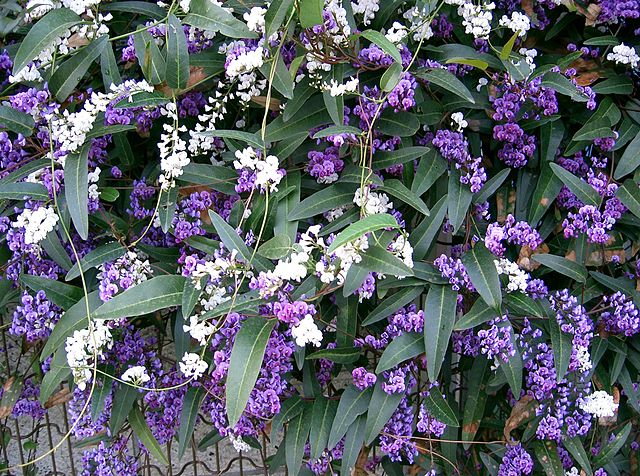
It is used as a landscape plant in the southwestern U.S. where it is commonly called lilac vine, and occasionally Mexican lilac vine.
Happy Wanderer blooms profusely in late winter and spring with long cascading racemes like a Wisteria. The vine is much smaller at maturity and also tolerates dry conditions once established.
Purple, or occasionally pink or white, flowers to almost half inch across are borne in pendent racemes throughout much of the year.
Cold hardy to about 22 degrees.
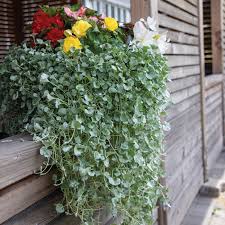
Cannot ship to HI.
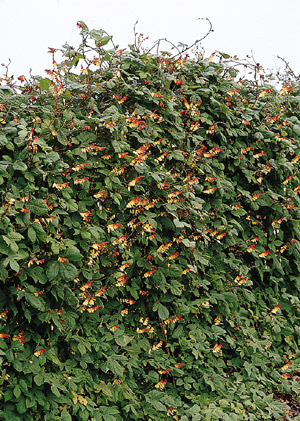
A nice cover for shed walls or fences or pump houses, will grow to 18 feet, but can also be pruned to any size you desire.
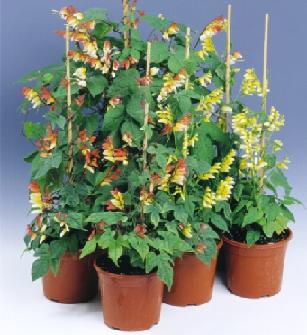
They will attract pollinators to your garden such as Hummingbirds, Butterflies, and Bees while being resistant to Deer and Rabbits. A winner of the RHS’s Award of Garden Merit, the racemes or sprays spark with blooms that shift from red to white.
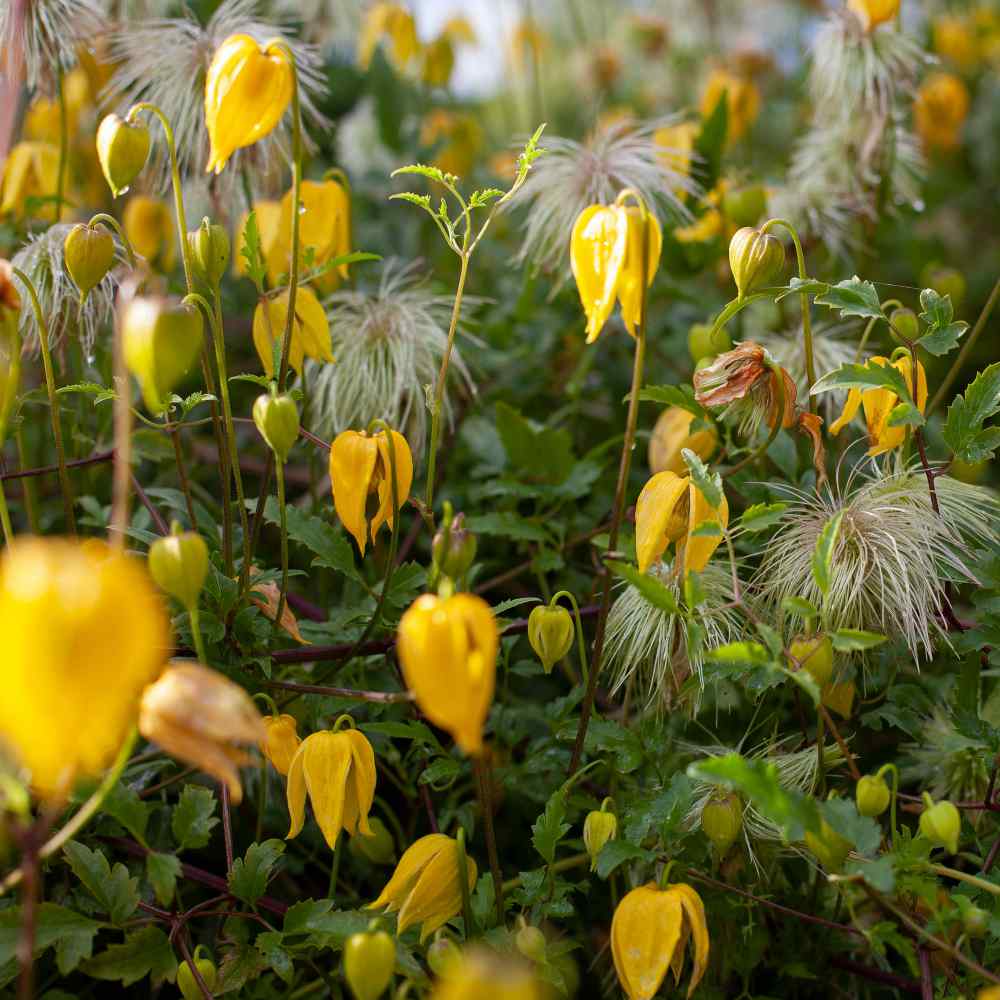
The 3 inch yellow blooms also produce feathery silver seed heads. This vine is great for trellises and arbors, and also does well in containers as an annual. This Clematis plant will both summer and fall. Zones 5-9.
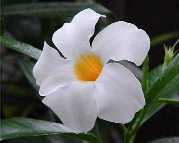
The tubular flowers are 2 inches long and flare open to 2-1/2 inches wide with what is described as a heady vanilla aroma most pronounced in the evening but some seem not to be able to smell it at all. The flowers are followed by pairs of long bean-like fruit pods - these fruit and the fragrance cause some to call this plant the vanilla bean vine though it certainly should not be used in cooking. Plant in full to part sun (blooms best in full sun) and water occasionally to regularly. Tolerates most soils and is root hardy to at least 12 degrees (we have seen claims to below 0 degrees ) and deciduous in most California gardens as temperatures near freezing. Prune in late winter prior to new growth starting and watch for aphids on the flower buds.


Dutchman's Pipe is a very vigorous native vine. It will create a thick green screen in a short period of time making it ideal for covering a fence, wall or strong trellis. It can grow to 30 feet tall in some cases.
It has large, dark green, heart-shaped leaves and very interesting flowers that are shaped like a small pipe. They are a few inches long and are a mahogony-cream color.
This vine plays an important role in the life of native Pipevine Swallowtail butterflies. The flowers provide nectar for the butterflies, and the leaves are an important food source for the caterpillars. The vigorous growth of this vine makes it easy to share the leaves with these beautiful insects.
This native plant grows best in moist, well-drained soil, in full to partial sun. It can reach heights of 30 feet tall. It is a good plant for having few pest or disease problems, and as a bonus it withstands urban pollution quite well.
For zones 4-8.


Silver Falls is characterized by silvery leaves, glistening silver stems, and a cascading habit that can spread up to 5 feet. Easy and fast growing from seeds, this Dichondra plant is simply one of the showiest accents around for all your containers and bare garden spots. The 3/4 - 1 inch leaves have a thick, super-soft texture and neat fan shape. Just like Emerald Falls, this adorable foliage plant needs no pinching.
Quicker than you can say Silver Falls, this cascading beauty will be 3 to 5 feet long, but only growing 3 - 5 inches tall. It is also very heat and drought tolerant making it the perfect plant for sunny locations. Silver Falls recovers quickly even if wilted, and looks fresh all season long.

Very interesting edible fruits, resembling a sausage in shape and reaching 4-5" long. May be grown in full sun or partial shade. All Akebia species retain their attractive leaves through most of the winter, are excellent for growing on walls, fences, trellis.
Best planted in a sheltered position. It can be trained up various kinds of garden supports, or alternatively, allowed to climb up a tree. Hardy to 24 degrees.

Very heat- and drought-tolerant, it recovers quickly even if wilted, and looks fresh all season long. Try it in a large container behind super-cascading Silver Falls, or among trailing flowering plants from Periwinkle to Sweet Pea.
Emerald Falls thrives in full sun and well-drained soil. Start the seeds indoors in late winter (about 6 to 8 weeks before last anticipated frost) and then set out when the weather warms up in spring.
Multiseed Pellets ( each pellet contains 6-8 seeds ).


A perennial climbing liana native to West Indies, Mexico and Argentina. Cats claw vine is a long lived plant that grows relatively slow. It can reach up to 75 feet in height. Cats claw vine gets its name from the 3-pronged claw-like climbing appendages that are used to grasp onto plants or surfaces. The plant has a semi-persistent foliage.
Has bright yellow trumpet shaped flowers. They bloom in early summer. Its leaves are glossy green with two leaflets per petiole.
The fruit is glossy green and turn dark-brown as they mature. Each fruit contains numerous papery seeds. Needs full sun to part shade. It is drought tolerant. With self-clinging suction cups that are gentle on masonry, this quick-spreading vine can easily dress up an unsightly wall or frame a doorway or window. Macfadyena unguis-cati is a low maintenance, heat loving plant making it a great choice for warm landscapes.
For zones 8-10.

Cypress Vine plants grow well in full sun or partial shade. They are not picky about the quality of soil, but it does need to have good drainage. Once the Cypress Vine Star Glory plant is established well, it can withstand periods of drought. However, it will grow faster and have more blooms with regular water. Deadheading the spent blooms will encourage a prolonged bloom season. Blooms will usually start the first of summer and continue until fall. In some frost free areas, Cypress Vine will grow as a perennial.
Black pepper plants make an attractive addition to your house or garden. Once grown, they develop dainty white flowers before producing fruit. The fruits will appear as clusters of round berries in a chain formation.
Conditions for growing black pepper plants require high temps, heavy and frequent rainfall, and well-draining soil, all of which are met in the countries of India, Indonesia, and Brazil where most of the commercial peppercorns are grown. Most growers in the USA grow these in containers inside the home or greenhouse. These warm loving plants will stop growing when temps drop below 65 degrees F. (18 C.) and do not tolerate frost; as such, they make great container plants. Situate in full sun with 50 percent or greater humidity, or inside the house or greenhouse if your region does not fit these criteria.
In its native habit of southern India, Black Pepper is an understory plant that climbs up trees and grows in dappled light. When grown as a houseplant, it needs moderate light in an east or west window and it should be placed directly on the windowsill or close to your light source if grown in a light garden. It does benefit from some direct sunlight but not hot noonday sun. Like other tropical plants, Black Pepper can be grown outside during the summer months and brought inside for the winter.
The flowers start growing at the leaf nodes of new growth. The small white flowers form pendulous spikes and then small, round, green peppercorns form in chains, which in time ripen to red. Growth slows down in the winter, yet it will fruit and flower year-round. The pepper plant can produce an abundance of peppercorns in a pot as small as 8-inches.
To fertilize, use a soluble or liquid fertilizer applied every two weeks when you water. Don’t over fertilize your black pepper plant, as a rule of thumb, the less light, the less often you fertilize, so outside in summer means more, inside in winter less.

Trumpet vine is easily grown in a wide variety of soils. It is best planted in lean-to-average soils with regular moisture in full sun to partial shade. Foliage grows well in shade, but plants need good sun for best flowering. It blooms on new growth, so early spring pruning will not affect the flowering. Vines must be grown on sturdy structures because mature plants produce considerable weight.
The challenge with species plants is usually not how to grow them but how to restrain them, in large part because they sucker profusely from underground runners and freely self-seed, often forming impenetrable colonies in the wild, which can choke out many plants that get in their way. To keep it in check, plant it near concrete or an area that you can mow; mowing down the suckers will discourage them. Good landscape uses include planting it in a woodland garden or naturalized area. It is also appropriate in native and pollinator gardens.


The Loofah Gourd is a member of the Cucurbitaceae ( Gourd ) family. The Loofah is spelled several different ways, i.e., Lofah, Luffa or Lufa. It's commonly known as the Washrag Gourd. It is the only plant known that can be raised and used as a sponge. The sponges are very versatile in that they can be used for bathing, washing dishes or scrubbing. The Loofah is widely used for bathing to invigorate the skin as well as gift giving and crafts. It is a very fast growing annual that produce vines up to twelve feet or more. I have seen them grow over 20 ft. high in trees and produce dozens of gourds per plant. When fully matured, you can peel off the dried and crisp outer shell to expose the fibrous sponge. To clean your Loofah you wash it in clean water and then soak it in a solution of bleach and water and allow to dry in the sun. Loofah sponges will last a long time if washed and allowed to dry after each use. Here are some helpful links on growing and harvesting the loofa sponge:
How to grow natural loofa sponges.
How to harvest your luffa and turn them into sponges.



Climbing Snapdragon grows fast and easily. Despite how delicate it appears, it is quite tough. Cut Asarina back if it gets shabby and it will bounce right back. Plant the seeds in rich soil with average moisture. It is considered to be a tender-perennial, and in frost free zones, it will be evergreen. With a frost, Asarina vine will die back, but it may have new shoots in the spring. Give it a top dressing of compost once a year in early spring.

White Thunbergia vines grows best in full sun. They needs average, well-drained soil. Plant seedlings 3 inches away from supports. Netting or strings make good trellis material. Solid fencing or large posts will need trellis material for the vine to climb. Space plants 8 - 12 inches apart. Pinch the tips of young Black-Eyed Susan plants to encourage branching. In areas of no frost, white Thunbergia vine will grow as a perennial. In colder climates, grow it as an annual, sowing the Thunbergia seeds each year. If grown in a container, Thunbergia Black Eyed Susan vine can be wintered indoors in a bright, sunny window.
It is recommended to soak the Black-eyed Susan vine seeds over night in tepid water. Following the soaking, sow Thunbergia seeds outdoors after the last frost in prepared seed bed. Or, to get a jump start on the growing season, sow Thunbergia Alata seeds indoors 6 - 8 weeks before outdoor planting. Thunbergia flower seeds germinate better in darkness.


Thunbergia vines grows best in full sun. They needs average, well-drained soil. Plant seedlings 3 inches away from supports. Netting or strings make good trellis material. Solid fencing or large posts will need trellis material for the vine to climb. Space plants 8 - 12 inches apart. Pinch the tips of young Black-Eyed Susan plants to encourage branching. In areas of no frost, Thunbergia vines will grow as a perennial. In colder climates, grow it as an annual, sowing the Thunbergia seeds each year. If grown in a container, Thunbergia Black Eyed Susan vine can be wintered indoors in a bright, sunny window.

Purple Bells needs rich, well-drained soil and full sun to partial shade although it prefers afternoon shade in hotter climates. Purple Bells bloom from late spring to late fall. Annual




This evergreen climbing plant thrives on both vertical and horizontal surfaces. It climbs fortuitously with the aid of aerial rootlets which firmly cling to various substrates, be it trees, cliffs, or walls. The plant exhibits versatile foliage with palmately five-lobed juvenile leaves on creeping stems and unlobed cordate adult leaves on fertile flowering stems exposed to full sun. Approved by the German Commission E Monographs for cough and bronchitis treatment, English Ivy is recognized for its medicinal benefits.
Although native to Europe and Western Asia, it has become a common sight in gardens and waste spaces across various lands. It's noteworthy that it's considered an invasive species in numerous areas, specifically in the eastern United States and Oregon, where it's sale or cultivation are banned. The beauty of the English Ivy is in its evergreen nature, enigmatic grip, and charm that can convert any unsightly facade into a delightful view. If you are considering using Hedera helix, careful planning and management are recommended. Hardy to -40 degrees, for zones 4-9. Cannot ship to OR.

You can easily grow Boston ivy as houseplants that will climb on an indoor trellis or other structure. This is easily accomplished, as Boston ivy plants readily climb by tendrils with adhesive disks.
Boston Ivy is a sensible alternative to ivy, a perennial climbing vine that is gentler on masonry and an even more vigorous grower (its reach can top 30 feet at maturity). It is a well-behaved climber, with vines that won’t destroy your masonry or cause cracks in the facade of your house. It is best suited for zones 4-8.

Wisteria sinensis, commonly called Chinese wisteria, is a deciduous vine that grows vigorously to 25’ or more and features 6-12” long racemes of mildly-fragrant, pea-like, blue-violet flowers in May when the foliage is just beginning to expand. Flowers bloom somewhat simultaneously on the racemes thus producing a dramatic floral display. Flowers give way to pendant, velvety, bean-like seed pods (4-6” long) which ripen in autumn and may persist into winter. Compound, odd-pinnate, deep green leaves (each leaf typically with 7-13 leaflets).
In contrast to the very similar Japanese wisteria (Wisteria floribunda), Chinese wisteria differs by counterclockwise twining, fewer leaflets per leaf, shorter flowering racemes of less fragrant flowers that bloom simultaneously on each raceme and blue violet flower color. Over time, the stems of this vine become twisted, trunk-like and massive.
You should plan ahead when planting this vine. It must be sited and trained only on sturdy structures which will be able to support the considerable weight of the mature vine. This is an excellent vine for large, sturdy, freestanding arbors, pergolas, posts, trellises, fences or terrace walls, and can be particularly effective when grown near or above patios where the flowers can be enjoyed in season. May also be trained as a specimen shrub or tree.
Hardy to zone 5 and easily grown.

Prolific ornamental variety with light green, flat pods 12-16" long which are fine flavored when young and tender. Large shiny black and purple mottled seeds are tasty as a shell or dried bean. 80 days.

Kiwis require special training and pruning to produce good crops. When planted, the vines should be pruned back to 4 or 5 buds. From these a main stem should be selected and staked to grow to the top of the arbor or trellis, usually 6-7’ high. The trellis should be strong to support the heavy future fruit loads.
Kiwis are beautiful vines. Their vigorous spring growth is a spectacular sight. Excellent for a privacy screen, they will rapidly cover a fence and with support will cover a wall or steep slope. Kiwis grow in a manner similar to grapes but more rapidly. They are very high in Vitamin C. (Ten times as much as lemons.) They are excellent for eating fresh and are a tasty addition to salads and desserts. Ice cream, pies, jam and wine are other ways to use kiwis.


Blooms and pods can used for cutting. Twining growth to 10-20 feet tall.
Perfect for trellises, arbors, walls or fences. Perennial in zones 9 and 10, it can be grown as an annual everywhere.

Easy to grow in poor, acidic to alkaline soils. Lablab beans take 90-150 days from sowing to maturity. Immature pods can be picked sooner. Needs full sun for best growth. Requires well-drained soil. Once established, lablab bean is drought tolerant, more so than most beans.
Young immature pods are cooked and eaten like green beans (older pods may need to be de-stringed). They have a strong, beany flavor and some people like to mix them with other beans or green vegetables. Unfortunately, the purple color disappears during cooking. Young leaves are eaten raw in salads and older leaves are cooked like spinach. Flowers are eaten raw or steamed. The large starchy root tubers can be boiled and baked. The immature seeds can be boiled and eaten like any shelly bean. Dried seeds should be boiled in two changes of water before eating since they contain toxic levels of cyanogenic glucosides. In Asia the mature seeds are made into tofu and fermented for tempeh. They are also used as bean sprouts.
Lablab bean is a good choice for a quick screen on a trellis or fence. It grows fast, has beautiful, fragrant flowers that attract butterflies and hummingbirds, and it even produces edible leaves, flowers, pods, seeds and roots. Each summer I train a vine or two of lablab up the clothes line pole just for the color and fragrance.

Canary Creeper seeds should be soaked in water overnight to help break down the tough outer seed coat. Sow the Nasturium seeds directly outside and cover the flower seed 1/4 inch with soil. Canary Creeper care includes watering deeply, but letting the roots dry out in-between waterings. There is no need to either fertilize or deadhead the vine. The Canary Bird flowers, young leaves, and fruit are edible and, like its cousin the nasturtium, has the same peppery taste.


This close relative of the morning glory has similar heart shaped leaves that are a rich green and 4-8 inches long. They provide a beautiful backdrop for the spectacular moonflowers.
This vine also known as the evening glory as its buds open in late afternoon and last only until morning's light transforms them into a limp shriveled mass.
Moonflower makes up for the brief lifespans of individual flowers by producing quantities of the big blossoms throughout the summer. These are held on a stem that bears several buds simultaneously, not all of which bloom the same night. The long 4 inch buds are also very attractive especially in the hours just before the flower opens.
And what a fabulous flower the moon vine produces! They are fluted funnels sculpted in purest alabaster white. About the diameter of a saucer measuring 5-6 inches across.
As if the moonflower was not already enchanting enough, it also has a delightful fragrance to complement its beauty and perfume warm summer nights.

Also known as Ceylon spinach, vine spinach or Malabar nightshade. It is a climbing perennial plant, mostly cultivated as an annual vegetable against a support in home gardens but in some areas as a vine like market vegetable without staking. Malabar spinach is not a true spinach (Spinacia oleracea L., chenopodiaceae), but its leaves, which form on a vine, resemble spinach, and are used in the same way. The plant is a native of the East Indies, and found its way to the New World from China. It has spread throughout the tropical world and it is one of the best tropical spinach widely adapted to a variety of soils and climates. It is particularly abundant in India, Malaysia, and the Philippines, but it is also seen throughout tropical Africa, the Caribbean, and tropical South America.
Malabar spinach has thick tender stems and the leaves are almost circular to ovate, alternate, and short petioled. The flowers, borne on axillary spikes or branching peduncles are bisexual and inconspicuous. The fruits are fleshy and purplish black and the juice is sometimes used as a dye.
The succulent young and mature leaves, and the stems are eaten. The most common method of cooking is as a pot herb, mixed with stew or other vegetables. The leaves have mild flavor. Malabar spinach is a good source of vitamins A and C, calcium, and iron.
Malabar spinach is a perennial that tends to extend itself over time. Seeds can be sown directly or vines may be established directly from stem cuttings. These need a little shade on transplanting, but root readily. Malabar spinach can thrive under conditions of moderate soil fertility, but is quite responsive to nitrogen fertilizer. Can be harvested at 57 days after planting.

The seeds are very unique with a hard shell of dark brown to black, and each seed has a perfect cream colored heart. The flower seed gives the plant another one of its common names, Heartseed Vine. Another common name for Cardiospermum is Love in a Puff Vine.
Also known as Kanphuti. A climbing annual common throughout India. Leaves are mixed in castor oil to treat stiff limbs, rheumatism and lumbago. Root has diaphoretic, diuretic and laxative properties.
Leaf juice is used for earache. Cooked and eaten in India and Africa. Decorative black seeds with cute heart-shaped white faces are used for necklaces.

Features: A vine with beautiful dark green heart shaped leaves and paler underneath. These are about 3 inches long by 1-1/2 inch wide and grow closely together to create a dense mass of foliage. These slender woody stems twine gracefully in tight coils around fence wire and other supports lifting itself to heights of 6 to 30 feet. Stems age to woody.


It performs well even in full shade, and it loves to cascade down a stone wall or spill over the sides of containers. The plant also makes charming hanging baskets. This trailing vine takes very little maintenance except for regular waterings, and being cut back and deadheaded before setting seeds.
It is a prolific self-sower, spreading its seeds all over the garden. To keep it more contained, deadheading is helpful. Kenilworth Ivy makes a very nice flowering ground cover plant. Ground cover plant that is also ideal for rockery. Perennial, hardy for zones 5-9, grows 4 inches tall.
Sow seeds indoors 10 weeks before the last frost is expected. Use starter trays, sow the ground cover seeds on the surface of sterile soil, gently pressing the seed into the soil.
Do not cover the seeds. They need light to germinate. After danger of frost has passed, transplant the young ground cover plants into the garden.
Average germination time is 14-24 days.

Blue passionflower likes loose sandy or gravelly soils and does best planted in old brick rubble that retains heat during cold winter weather. Too much manure or compost will result in lush vegetative growth and poor flowering. This species will flower in a small pot, but it prefers plenty of root space and will do better in a roomy container. In Zone 8-9, the ideal location is against a warm south-facing old brick wall where an overhang prevents excessive drenching by heavy rains.
Go light on fertilizer and water deeply, but infrequently; passionflowers should be encouraged to reach deep into the earth for water. When motivated to do so, they are capable of developing amazing root systems to sustain them through droughts and freezes. Passionflowers love high humidity, but they are subject to fungal diseases if they don't get good air circulation in the greenhouse. Blue passionflower does better overwintered in a cool greenhouse where it can go semi-dormant as opposed to in a hothouse where it will be tempted to put too much energy into weak off-season growth. In either case, it is important to keep the soil on the dry side in the winter.
Blue passionflower may be wound around a hoop support to keep it within bounds so that it may be grown as a houseplant in a sunny south-facing window. Passifloras flower on new growth, so they may be pruned early in the growing season. It is best to cut some stems back nearly to the base, rather than just trim the tips. The terminal buds may be pinched out to encourage branching. Always keep some green foliage on the plant to keep the sap rising and encourage rapid regrowth. The roots may be weakened and become subject to fungal infection if too much top growth is removed at once. Don't try to train a passionflower to be too neat and compact; branches allowed to hang loose and droop a bit will be the ones most inclined to flower. Passionflowers are subject to a wide array of pests and diseases, but most of them have minimal impact on well grown plants. Butterfly larvae are the exception; caterpillars readily devour the foliage of healthy mature plants.
Passionflowers like full sun and will scramble over trees and shrubs to get it.
Hardiness: USDA Zones 8-11. Blue passionflowers will regrow from deep roots after even severe freezes. They have been known to survive temperatures as low as 5 degrees when the ground was frozen over two feet deep! It is nevertheless important to keep the soil as warm as possible, especially in the winter greenhouse.

Fruit of the giant granadilla reach a length of up to 12 inches and turn yellow when mature. The pulp around the seeds is used to flavor ice cream and to make a cooling drink. In addition, the flesh of this fruit is edible. The green fruit is boiled and eaten as a vegetable. The fully ripe flesh is eaten alone or in combination with such fruits as papaya and pineapple

The outer shell is hard and slippery, and has soft padding on the interior to protect the seeds. The seeds, which are hard and black, are surrounded by a gelatinous sphere of transparent pulp. The pulp is the edible part of the fruit and has a soft sweet taste. It is very aromatic and contains vitamins A, C, and K, phosphorus, iron, and calcium.
Winter Hardiness: 25-30° F

Hops produce rich, heavily scented, green-golden fruit that is harvested in autumn. The flowers of Humulus lupulus contain the chemicals myrcene, myrcenol, resin, linalool, humulene and tannins, all used extensively in the pharmaceutical industy. Also, another common usage is flavoring for the beer industry.
Hops seeds can be slow to germinate. Use a process called "cold scarification" to encourage hop seed germination. A good method is to put seeds in an equal amount of moist sand and refrigerate from one to three months at about 41 degrees F. After that, plant the seeds at 68 degrees F. for one to two months. If the hops seeds have not germinated, put them back in the refrigerator and repeat the cycle.
Decorative fast growing vine, excellent for porches and screens.

Fantastical, 3 1/2 inch flaring violet and white bells sporting long sexy stamens create a massive bloom display that’ll be much admired by neighbors. Attractive, deep green, heart-shaped foliage. Give it room to grow, rich soil and stand back! Hummers will swarm! Cut back in Winter for bushiest appearance next year in warmer climates where it can survive as a perennial in zones 9-11.

Statuesque vine sports outrageously large and glamorous-looking blooms along its length that can extend more than 20 feet. Extremely vigorous and puts on a great show when staked in large containers. Buds open creamy green, then change to rosy-violet and mature to a rich purple. Height: 10-20'

This is the perfect flowering plant for hummingbirds, and they visit it all day long. Chilean Glory Vine looks delicate, but it is vigorous and easy to grow and is considered a perennial in USDA Zones 9 - 10, but it will grow like an annual in colder zones. For areas with a long growing season, start the Eccremocarpus Scaber seeds directly outdoors in a prepared seedbed. In colder zones, start the flower seeds indoors 6 - 8 weeks before the end of frost season.






